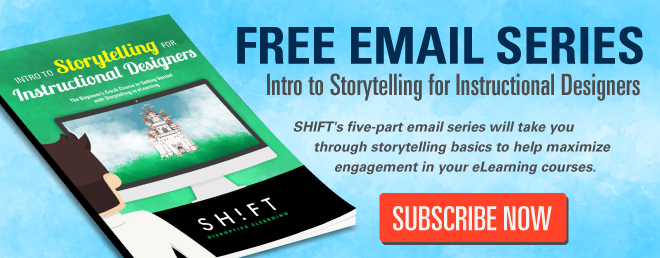So, you think you found your calling?
And you want to be an instructional designer?
That's great! You couldn't have chosen a more exciting job. But before you take the plunge, here's a reality check. Take off those rose-colored glasses and learn about the job of an eLearning designer as it really is.

1. There's no make-me-a-pro switch
Owning a few tubes of paint and some brushes do make you an artist if you cannot draw. Owning the latest Mac cannot make you a programmer if you do not know how to code. Stocking up on the latest kitchen appliances won't turn you into a Michelin Star chef if you don't know your spices and sauces. You got the idea, right?
The plethora of eLearning development software programs helps you create snazzy, glitzy courses. But you cannot get anywhere without your creativity, designing skills, and knowledge of the theories. Sorry, but there is no magic tool that will take your content-heavy boring slides and turn them into an engaging, interactive, and cohesive learning experience.
2. You have to work hard
What else did you expect?
Talent can get you the job. But after you have your foot in the door, you have to force your way in and make your way ahead with sheer hard work and lots of practice.
You have to keep up with the times and trends. Technology will zoom past you if you are not quick to learn the tools of the trade. Learners will demand to be wooed and hooked with more innovative designs; else they will pass you up in a jiffy. You HAVE to be on top of trends and mold yourself and evolve as the industry shapes. But there's nothing unfair in it. After all, you also don't wear a hat that went out of vogue a couple of seasons ago!
So practice, practice, and practice some more. You will never regret the midnight oil you have to burn to learn new skills or wrap your wits around the latest design software.
3. It isn't always glitzy graphics and oodles of fun
The snazzy courses you see all around look like the handiwork of designers who were making merry and having a ball when they created them. They definitely had fun while they were at it, but apart from creating stories and playing with images and colors, they also had to do a lot of "unglamorous" tasks.
They had to run around, shoot mails, or make sundry calls to schedule appointments with SMEs and then stayed up late to prepare for the interview. They had to do a lot of number-crunching and juggle around scarce resources and scanty timelines to prepare the budget. They had to go through sundry rounds of tweaking, modifying, and reworking designs before they got it right. In the midst of all these, they had to also come up with stellar storyboards and drool-worthy graphics.
4. Ideas won't dawn on you just when you need them
The world of eLearning is not made up of temperamental artists who come up with quirky ideas once in a while when their muses pay them a visit. To survive in this industry, you have to be a consistent performer who enthralls everyone with his out-of-the-box designs and innovative ideas.
Now here is the catch. Ideas tend to give you the slip just when you want one to strike. It can be frustrating, but that's how it is.
Fortunately, there are ways you can prevent an inspiration "drought." Create an inspiration or mood board. Pin pictures, write down your favorite quotes or passages from books that moved you, and jot down lyrics from songs or lines from poems. Your mood board can also contain patches of fabric, pictures of décor snipped off from magazines, and specimens from the natural world like rocks and leaves. Any story that touches you, any picture that moves you, and any shape that intrigues you should go up on the inspiration board. When you are short of ideas, gaze at the mood board.
Tip: Your mood board can also be on your computer or mobile device.
5. Pesky and demanding clients are a reality in eLearning
There is something intensely romantic and alluring about the solitary artist. But no, you don't get to be one if you are an instructional designer. You cannot work on your own and create your own masterpieces hoping that your clients will swoon over them. You have to play by your clients' wishes, and sometimes, read their minds to give shape to their unspoken ideas.
You have to deal with finicky clients and even give in to their whims and kill your darlings (read: chop off the favorite parts of your storyboard and re-do designs that you loved working on). What is more, you have to do all these with a smile on your face.
An instructional designer has to also work closely with SMEs. As part of your job, you are expected to interview SMEs, take down copious notes as they rattle off facts, concepts, jargons, and procedures, and gently steer them if they digress too much.
To be a successful instructional designer, you have to be someone who is comfortable being around and dealing with people with tact, compassion, and empathy.
6. People will dump their problems on you, and you have to provide the solutions.
Yes, that is what it all boils down to. As an instructional designer, you are expected to come up with creative and customized solutions to the professional woes of your learners.
Employees need to learn a new software program. They expect you to come up with an application-based training program. Business managers want to train their sales personnel on upselling techniques. You are called upon to create a scenario-based training program. Entrepreneurs want to learn a thing or two about team management. It is up to you to create a crisp and succinct course that will give them the low-down.
As an instructional designer, you have to be a problem-solver. You have to be intuitive, so you can understand your clients' needs. You also have to be insightful and innovative, so you can guide them effectively with practical solutions to tackle their real and pressing problems.
Being an instructional designer is a challenging job. But if you are motivated and passionate, don't let this reality check dampen your spirits. Instead create a checklist of what do you need to do to overcome the challenges and get going.
Other interesting reads:
- Breathe New Life into Your eLearning Courses: 5 Helpful Mantras to Live By
- The Golden Rules of High-Quality Instructional Design








